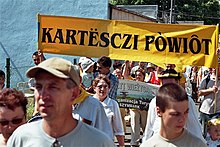| Lechitic | |
|---|---|
| Geographic distribution | Poland |
| Linguistic classification | Indo-European
|
| Subdivisions |
|
| Language codes | |
| Glottolog | lech1241 |
The Lechitic (or Lekhitic) languages are a language subgroup consisting of Polish and several other languages and dialects that were once spoken in the area that is now Poland and eastern Germany. It is one of the branches of the larger West Slavic subgroup; the other branches of this subgroup are the Czech–Slovak languages and the Sorbian languages.
Languages


The Lechitic languages are:
- Polish, used by approximately 38 million native speakers in Poland and several million elsewhere. Polish is considered to have several dialects, including Greater Polish, Lesser Polish, and Masovian, among others;
- Silesian, used today by over 530,000 people (2011 census) in Polish Silesia and by some more in Czech Silesia. The different varieties of Silesian are often considered to be dialects of Polish and Czech, and are sometimes seen as forming a distinct language;
- Pomeranian, spoken by Slavic Pomeranians, of which the only remaining variety is:
- Kashubian, used today by over 110,000 people (2011 census) in the eastern part of Pomerania. Sometimes it is considered a dialect of Polish;
- Slovincian, extinct since the 20th century.
- Polabian, extinct since the mid-18th century, a West Lechitic language formerly spoken by Slavic peoples in areas around the Elbe river in what is now the northeast of Germany.
Features
Common West Slavic features that are also present in Lechitic:
- χ́ > š́ in front of ě2, i2
- sk, zɡ > š́č́, ž́ǯ́ in front of ě2, i2
- χ́ > š́ after i, ь, ę, ŕ̥
- epenthetic l only in initial position after soft labials
- -ě3 in the nominative/accusative plural and genitive singular (duš́ě3) and accusatieve plural of kon’ě3 (instead of -ę)
- replacement of the instrumental singular ending -omъ with -ъmъ
- Creation of the nominative masculine/neuter singular ending/active preterite participle ending -a (reka, nesa instead of reky, nesy
- õrt-, õlt- > rot-, lot- (rola, radło)
- (ti̯, di̯ >) t́̄, d́̄; kt́ > ć, ʒ́
- Extension of the pronoun tъ > tъnъ
- Replacement of č́ьto with co via the genitive singular č́ьso
- Use of the compound adjectival genitive and dative masculine/neuter singular endings -ego and -emu through analogy with jego, jemu
- Temporal adverbs ending in -dy instead of -da
- Creation of the conjunction of intent aby
- Tendency for establishing a non-mobile accent
- Tendency to raise long vowels
There was no Proto-Lechitic language, but rather Lechitic languages are a group of dialects with many shared features. The central and eastern territories came under the control of the Piasts, which created a political, cultural (especially religious) unit, which caused the Pomeranians and Polabians to have weaker contact, as the Pomeranians were absorbed into the state by Mieszko I and began integrating with the Eastern Lechites.
Common Lechitic features include:
- Labiovelarization of *telt (but compare Polabian mlåkə and Kashubian/Slovincian młȯko; also czółn)
- Replacement of *tort, tolt, tert, telt
- In accented and preaccented syllables (i.e. under rising intonation): tórᵒt > tᵒrot > trot
- In circumflex and post-accented syllables (i.e. under falling intonation) *tolt > tòlᵒt or ‘tolòt > talt
- Softening of consonants before front vowels
- Velarization of ŕ̥
- Development of sonants (voiced consonants) into complex groups of a vowel and a consonant r, l
- west and central ĺ̥ l̥ > oł > åu̯; Pĺ̥T (before a non-back hard consonant_ in the northeast > ‘el, in the south > ‘il; after TČKP and Pĺ̥T in the northeast ĺ̥ l̥ > oł
- ŕ̥T, r̥ > ar (and then in Polabian > or); ŕ̥T́ > ir (Polabian) > er >ar, or > (Polish) ir, iř > er, eř (which hardens before labials and ch)
- Hardening of consonants before r̥ < ŕ̥T
- *ěT > ‘a (Lechitic ablaut)
- *ęT > ǫ
- eT >’o
Sample text
The following is the Lord's Prayer in several of the Lechitic languages:
| Polish | Upper Silesian | Kashubian | Polabian |
|---|---|---|---|
|
Ojcze nasz, któryś jest w niebie, |
Fatrze nŏsz, kery jeżeś we niebie, |
Òjcze nasz, jaczi jes w niebie, |
Nôße Wader, ta toy giß wa Nebisgáy, |
Etymology
The term Lechitic is applied both to the languages of this group and to Slavic peoples speaking these languages (known as Lechites). The term is related to the name of the legendary Polish forefather Lech and the name Lechia by which Poland was formerly sometimes known. For more details, see Lechites.
See also
Notes
- Lekhitic languages, Encyclopædia Britannica. Retrieved July 2008
- ^ Narodowy Spis Powszechny Ludności i Mieszkań 2011. Raport z wyników Archived 2012-12-21 at the Wayback Machine – Central Statistical Office of Poland
- Karol Dejna (1973). Dialekty polskie. pp. 59–60.
- Karol Dejna (1973). Dialekty polskie. pp. 64–65.
- Karol Dejna (1973). Dialekty polskie. p. 65.
- Karol Dejna (1973). Dialekty polskie. pp. 65–81.
- "Endangered Languages Project – Upper Silesian – Ôjcze nasz". www.endangeredlanguages.com. Retrieved 20 April 2021.
- File:Jerozolëma, kòscel Pater noster, "Òjcze nasz" pò kaszëbskù.JPG
- Das polabische Vaterunser / "Our Father" in Polabian
| Slavic languages | |||||||
|---|---|---|---|---|---|---|---|
| History | |||||||
| East Slavic | |||||||
| South Slavic |
| ||||||
| West Slavic |
| ||||||
| Microlanguages and dialects |
| ||||||
| Mixed languages | |||||||
| Constructed languages | |||||||
| Historical phonology | |||||||
| Italics indicate extinct languages. | |||||||